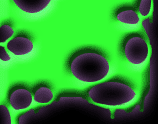Every October 31st, Americans join together in an attempt to scare the daylights out of one another. On this autumn night, the macabre becomes thrilling and often riotous. The thrill of a good scare is nothing new to the human race, and neither is Halloween a newcomer on our calenders. It is this joining of fear and jubilation that has kept it a vibrant holiday for more than two-thousand years.
The world had plenty of real things to fear back when the Celts of northen Europe celebrated the first festival of Samhain. ( pronounced " SOW-in " - the word means " end of summer " ) Since the Celts recognized only two seasons, Samhain also marked the beginning of winter, and the festival joined the celebration of the harvest with the observance of the Celtic New Year. This was the one night that exsisted outside real time, when the veil between the living and the dead was most permeable. People anxious about what the future would hold performed divination spells, which were believed to be most powerful when spirits were roaming the earth. Families set out food and wine, just in case their departed ancestors dropped in for dinner in the form of a black cat.
There must have been something deeply unnerving about sitting at home waiting for spirits to manifest, because Samhain also inspired a clever means of self-preservation: camoflage .
Throughout the land, people dressed up as ghouls and ghosts to blend in with the real ones, and then lead parades out of town in the hope of luring evil spirits away from their homes. Meanwhile, Druid priests built elaborate hilltop fires to encourage the sun to return at the end of winter; for good fortune, familes would replace the fires in their hearths with embers from a Druid's bonfire, which they carried home in hollowed-out turnips . To fend off evil spirits that might interfere with their safe journey home, they would carve scary faces into their turnips - the first jack-o-lanterns . In the Middle-Ages, the Catholic Church competed with Samhain by launching the trio of Christian holidays known as Hallowmas - October 31st became All-Hallow's Eve ( later shortened to Halloween ), November 1st became All Saints' Day, and November 2nd was named All-Souls' Day to honor non-saints. In place of setting out treats for the deceased, the faithful were encouraged to offer " soul cakes ", small pastries and breads, to the poor in exchange for their prayers for departed family members. Villagers continued to masquerade, but now they dressed up as angels, saints or ghosts, and visited from house to house, an entertainment that evolved into trick-or-treating . Ironically, the Christian plan to subvert Samhain codified the holiday instead; Halloween remained the night of Hallowmas that was least associated with religion --- just right for universal appeal in the diversly populated United States.
Still, Halloween's association with Catholicism meant it did'nt travel well to the Amaerican colonies. Besides, with the Salen Witch Trials, the Puritans made suggestions of the occult literally life-threatening; parading around in devil suits would hardly have been wise. But in the following years, autumn festivals hinted at what was yet to come with ritual ghost stories, apple bobbing, and pranks. Each new immigrant group contributed its own folklore to the celebrations. When the nineteenth century brought its huge influx of Irish and Scottish immigrants, America was ripe foe Halloween to take hold.
Victorian America welcomed Halloween as a new twist on harvest festivals --- and saw it as a terrific excuse to throw a theme party. Popular newspapers and magazines, finding good copy in the quaint superstitions of the past, spread the holiday across the nation. Divination, jack-o'-lantern carving ( our pumpkins replaced Brittish turnips ), and all manner of Halloween and harvest-inspired games were the rage, and parties competed with the sport of mischief-making. Eventually, Halloween parties fell out of fashion with young adults, leaving the holiday to its rightful heirs: children. Trick-or-treating becane a national pastime --- the phrase itself a nod to the mischief that would ensue if a masquerading visitor was not adequately " treated ".
Remarkably, Halloween today creates a communion of spirits not so very unlike that of the ancient Celts. Every year, history adds new characters to the cast of characters that trick-or-treaters choose to bring to life; a local Halloween parade might include Julius Caesar and George W., flesh-eating zombies, and walking boxes of Cracker Jacks. But modern Halloween also has something else in common with the ancient Samhain: We face head-on what we find scariest, because maybe together, outfitted in our supernatural best, we can poke fun at our fears --- and conquer them once and for all. Have a Happy and Safe Halloween!

